The NVIDIA GeForce GTX 1650 Review, Feat. Zotac: Fighting Brute Force With Power Efficiency
by Ryan Smith & Nate Oh on May 3, 2019 10:15 AM ESTFinal Fantasy XV (DX11)
Upon arriving to PC earlier this, Final Fantasy XV: Windows Edition was given a graphical overhaul as it was ported over from console, fruits of their successful partnership with NVIDIA, with hardly any hint of the troubles during Final Fantasy XV's original production and development.
In preparation for the launch, Square Enix opted to release a standalone benchmark that they have since updated. Using the Final Fantasy XV standalone benchmark gives us a lengthy standardized sequence to utilize OCAT. Upon release, the standalone benchmark received criticism for performance issues and general bugginess, as well as confusing graphical presets and performance measurement by 'score'. In its original iteration, the graphical settings could not be adjusted, leaving the user to the presets that were tied to resolution and hidden settings such as GameWorks features.
Since then, Square Enix has patched the benchmark with custom graphics settings and bugfixes to be more accurate in profiling in-game performance and graphical options, though leaving the 'score' measurement. For our testing, we enable or adjust settings to the 'Highest', 'High', or 'Medium' options except for NVIDIA-specific features and 'Model LOD', the latter of which is left at standard. For High, we also turn off the hi-res assets, while for Medium we also turn off 'Geomapping' (terrain tessellation). Final Fantasy XV also supports HDR, and it will support DLSS at some later date.
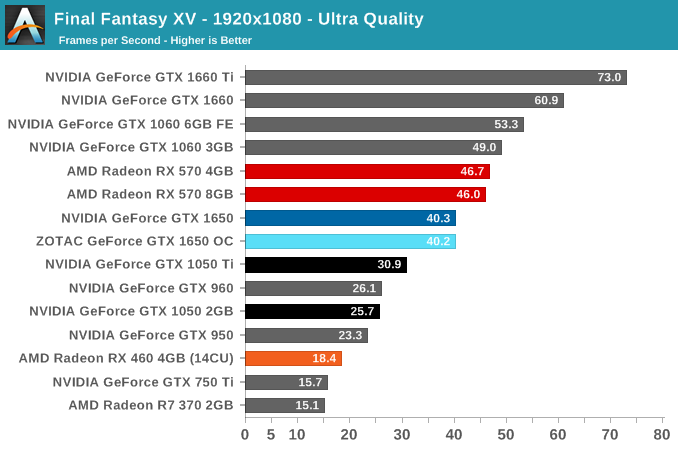
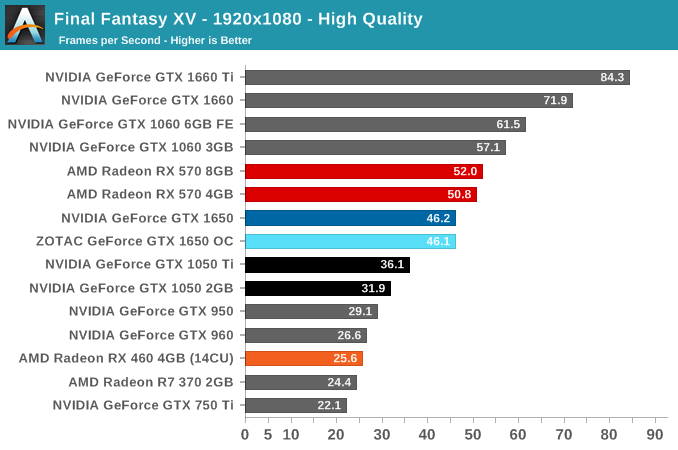
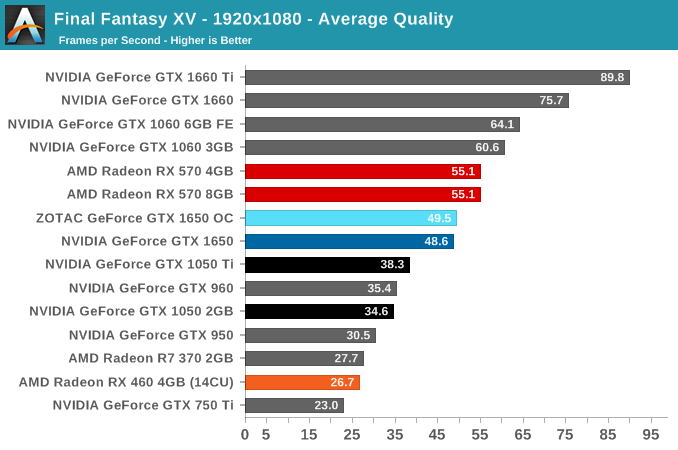
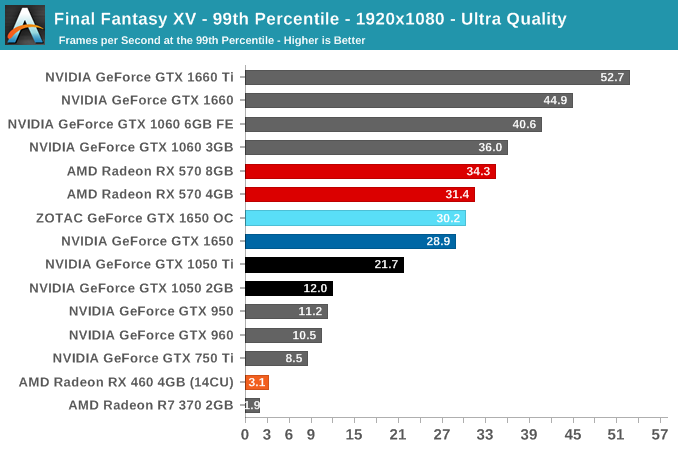
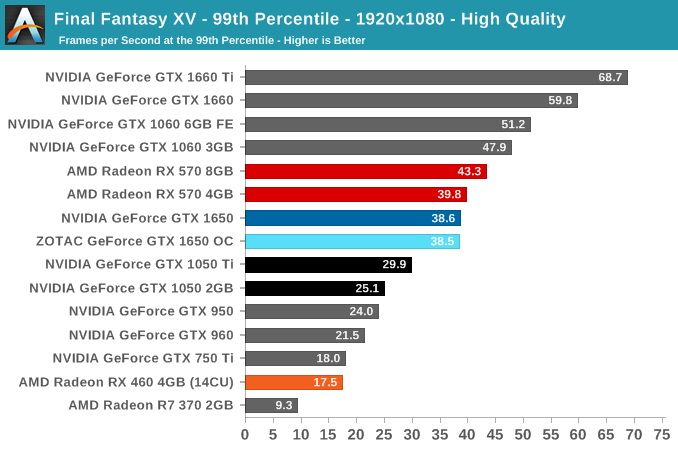
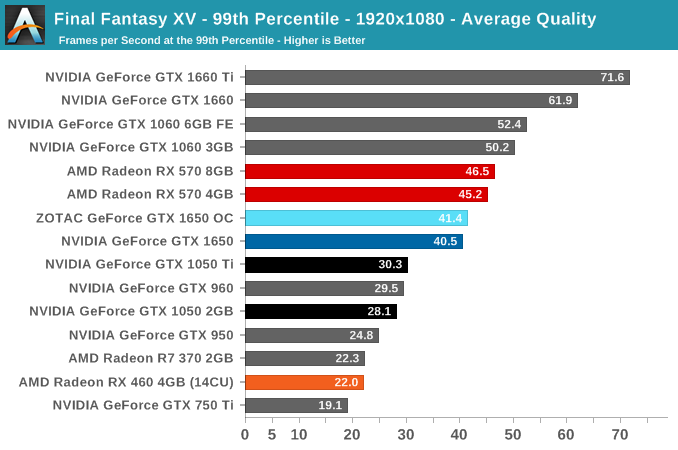
Final Fantasy V is another title that tends to prefer more VRAM, and with ultra settings and high-res textures, all the 2GB cards drop off in their 99th percentiles, reflecting the stuttering experience. The GTX 1650 is almost on par with RX 570 here at the higher settings.











126 Comments
View All Comments
dromoxen - Monday, May 20, 2019 - link
Its the current person mopping the floor who designed AMD's last generation of gfx cards.Another reason to buy this Crda is that you may not want the heat produced . I for one have started to use a 10w NUC in prefernece to a 75w HTPC just becuase the heating effect is less . UK,not jamaica or Saudi
plonk420 - Friday, May 3, 2019 - link
thanks for all the compute benches! yuuuugely appreciated!ads295 - Friday, May 3, 2019 - link
Can I use this to play ten year old games in full glory at 1440p?Ryan Smith - Friday, May 3, 2019 - link
Easily. Heck, depending on the game, you could probably get away with doing that on an iGPU.Ashinjuka - Saturday, May 4, 2019 - link
Probably not full-glory S.T.A.L.K.E.R. Definitely not full-glory S.T.A.L.K.E.R. with graphics mods.SaturnusDK - Friday, May 3, 2019 - link
Quite frankly at the $150, no one, and I do mean no one should buy this card. Even if you refurb an old OEM system the price difference up to an RX570 lets you buy a decent 80+ certified power supply and have a system that is more powerful and probably more power efficient at the same time. A standard OEM PSU in a an old computer is so inefficient that just replacing it makes up for more than the power consumption difference between a 1650 and an RX570. And gives you at least 15% more performance for the same amount of money spent.Oxford Guy - Saturday, May 4, 2019 - link
I doubt anyone should have purchased the 960 and yet it's the 5th most popular Steam card.This place didn't even bother to review it.
RSAUser - Friday, May 3, 2019 - link
A 1060 costs the same price as this 1650 here, I see no reason to buy it. Terrible value for money.RSAUser - Friday, May 3, 2019 - link
You can't compare the 1650 to the 950, they're priced completely differently at launch. Stop going directly with the product number. The 1650 is between 960 and 970.linuxgeex - Friday, May 3, 2019 - link
"Notably, B-frames incorporate information about both the frame before them and the frame after them, allowing for greater space savings versus simpler uni-directional P-frames."No. H.264 and H.265 (AVC/HEVC) have (optional) bi-directional P-Frames. That increases the complexity of the search required to create a B-Frame which would use significantly less data than a P-Frame. A lower-capability GPU may not be able to perform that search in real time, and in that case there's no point implementing it, even if it would increase compression efficiency, because the selling point of hardware HEVC compression is that it can be done in real time.
B-Frames are simpler than P-Frames. Not the other way around.
To be clear: I-Frames are effectively a still shot of the scene, like a JPEG.
P-Frames hold motion data with references to I-Frames and P-Frames - they encode linear motion for blocks in the image, they encode replacement blocks for new data needed to replace changes, ie when something moves over a background and reveals what was behind it.
If B-Frames are used, then intermediate frames are calculated between the P-Frames and their references based on their encoded block motion data. These result in what are called "tweens" in animation - images that are partway between a start and an end. The B-Frames encode small fixes for errors in the guessed (by linear interpolation) intermediate frames. The less motion there is, and the more linear the motion is, the more accurate the interpolated frames are and the more B-Frames you can have between P-Frames before the B-Frames become necessarily larger than a new P-Frame would have been. Generating those B-Frames and estimating / discarding them based on whether they can be as efficient as the P-Frames is a lot of work even when the P-Frames don't have bidirectional references. HEVC allows for more than just bidirectional (2 frame) motion prediction references. It allows using an P-Frame to inherit any other P-Frame's motion references and it allows P-Frames to target a B-Frame for motion estimation. That introduces an order of magnitude more search possibilities than H.264/AVC. HEVC with B-Frames disabled basically performs at a similar efficiency to AVC because all those options are off the table.